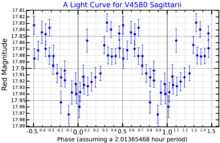SAX J1808.4−3658
This article needs additional citations for verification. (January 2017) |
| Observation data ICRS )
| |
|---|---|
| Constellation | Sagittarius |
| Right ascension | 17h 45m 39.73s[1] |
| Declination | −29° 00′ 29.7″[1] |
| Apparent magnitude (V) | 16.51 |
| Spectral type | Neutron star |
V4580 Sgr, PSR J1808−3658, SWIFT J1808.5−3655, INTREF 881, XTE J1808−369 | |
| Database references | |
| SIMBAD | data |
The first accreting millisecond pulsar discovered in 1998 by the Italian-Dutch
low-mass X-ray binaries
.

These accreting millisecond X-ray pulsars are thought to be the evolutionary progenitors of recycled radio millisecond pulsars. A total of thirteen accreting millisecond X-ray pulsars have been discovered as of January 2011. Three of them are Intermittent millisecond X-ray pulsars (HETE J1900.1-2455, Aql X-1 and SAX J1748.9-2021), i.e. they emit pulsations sporadically during the outburst.
On 21 August 2019 (UTC; 20 August in the US), Neutron Star Interior Composition Explorer (NICER) spotted the brightest X-ray burst so far observed.[4] It came from SAX J1808.4−3658.
References
- ^ a b "SAX J1808.4-3658". SIMBAD. Centre de données astronomiques de Strasbourg. Retrieved 15 January 2017.
- S2CID 4428048.
- .
- ^ NICER Telescope Spots Brightest X-Ray Burst Ever Observed
